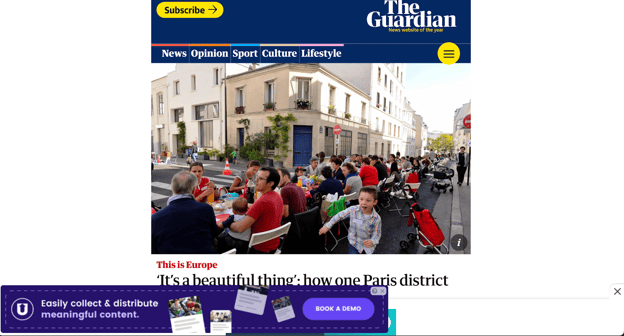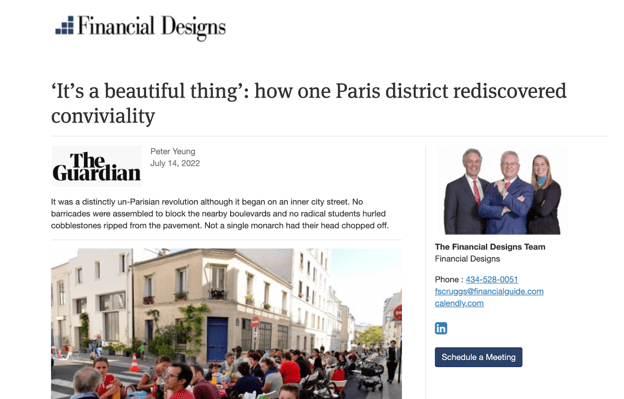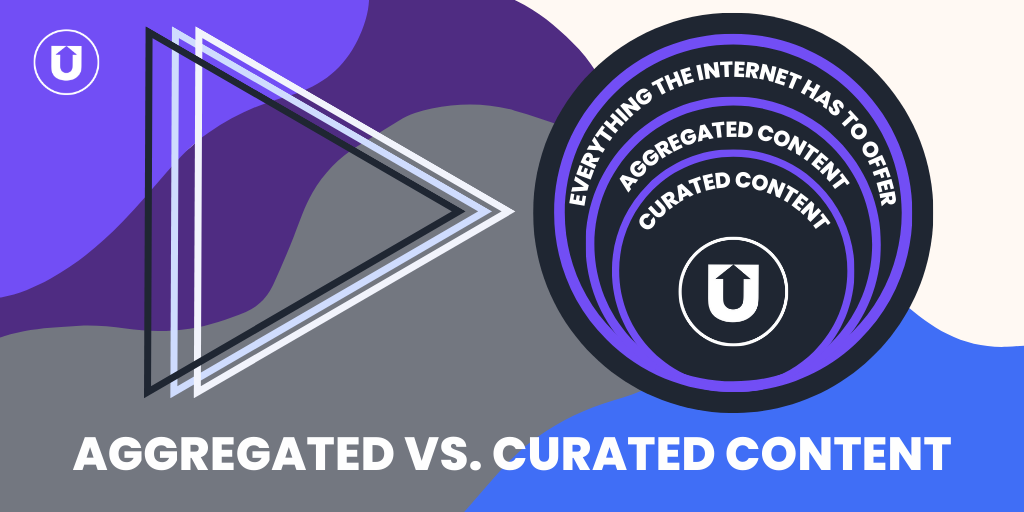What’s The Difference Between Content Curation and Syndication?
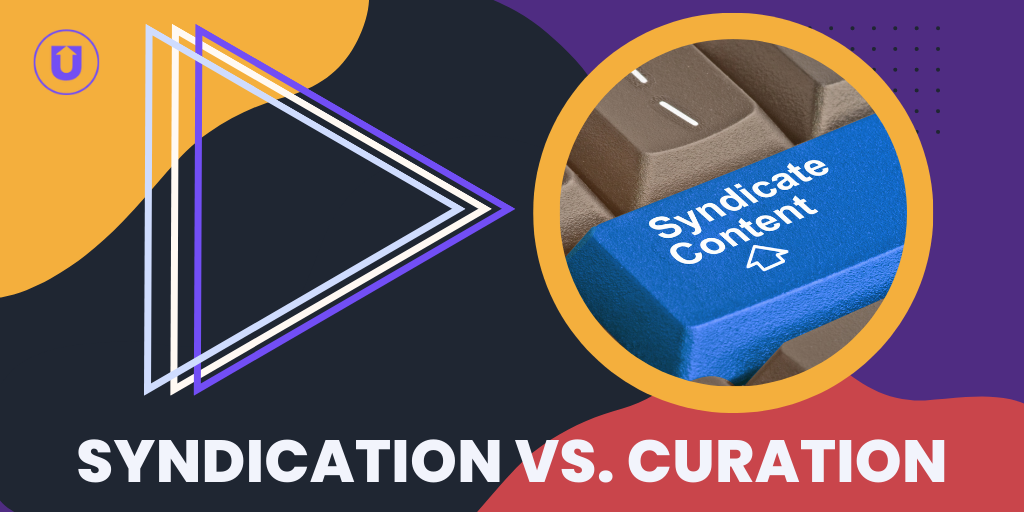
Creating content is essential for any marketing plan nowadays, but only creating content backs you into a corner, and nobody puts Baby in a corner.
That’s where marketing tactics like curation and syndication can help.
Content curation and syndication are great ways to become a resource in areas where you may not have unique expertise to valuable create content, but sharing thought leadership on these topics provides context to what your expertise is focused on.
UpContent is a former marketing firm turned content curation solution for hundreds of businesses. So we understand the need to find credible content that meets compliance standards while also growing your audience.
We have experience with both of these strategies, and there are pros and cons to both.
In this article, we’ll define content curation and syndication, some pros and cons, and some factors to help you choose the right strategy for your business.
What is Content Curation?
Content curation is distributing relevant third-party content with your audience that you didn’t create - and aren’t presenting as your own.
This can be on your website, social media profiles, email campaigns, and many other platforms.
Content curation is like a grocery store.
The grocery store didn’t manufacture all of the cereal (nor do they claim to), but they have curated several different flavors, kinds, and brands of cereal for you to choose from.
They know that if they only provided the cereal they did manufacture, the lack of choice would cause you to shop elsewhere (creation only).
They also know that if they stocked every cereal that is currently being manufactured worldwide the sheer amount of choice would be overwhelming to manage or shop for (aggregation only).
So they have selected what they believe to be the optimal number of their own cereals and added to that cereals from other manufacturers so you can be confident that when you go to their store you will find a cereal you are pleased with (creation and curation).
Isn’t that beautiful?
Pros of Content Curation
You also have access to ANY topic or article in the world when curating content.
Just like a grocer, your shoppers need to have confidence that what you are presenting to them reflects their needs and interests.
In order to gain that confidence, you need to have the ability to source anything they’d need.
If you can only source a limited amount of cereals, is the selection you are presenting what is best for the shopper or is it simpy limited by your access?
The same is true with the thought leadership you provide through your content marketing strategy.
To endear your audience and have them seek your insights, you must have access to all fo the insights available. Otherwise, the value you can provide is limited by your sourcing abilities.
For example, UpContent’s proprietary crawler scans the globe twice daily and discovers more than 50,000 articles a day.
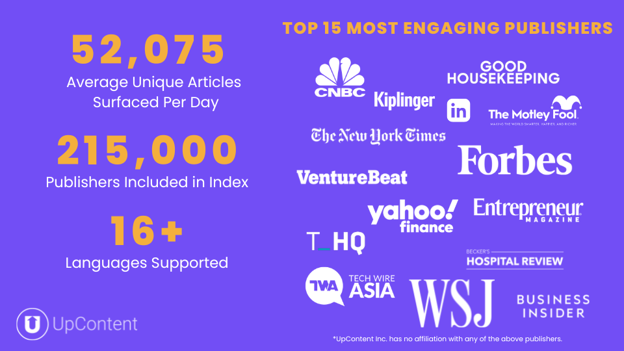
These articles come from 215,000+ publishers daily, and we continually add more.
This ensures that you are surveying the best for your specific topic areas and are plucking the best for your audience.
Content curation also helps develop your thought leadership by showcasing your interests and that you care about your reader’s interests.
It builds trust that you are willing to listen and share other expert opinions instead of only sharing your own with your created content.
It’s impossible for any grocer to have the best for everything (looking at you, Trader Joe’s), so the fact that you are presenting both what you’ve created that fills a void but aren’t trying to compete with those products that are already the best but are, rather, sourcing them for me is what gives me the confidence to not have to go to four other stores to compare.
The same is true with your audience and their content needs.
When curating content, you still get that SEO boost of a click on your website.
While the user will exit your site to read the article, your website can still get “credit” for the engagement on the page you’re displaying your curated library if the curated content is being displayed properly.
Cons of Curated Content
When your share curated content, the reader will still experience ads or paywalls depending on the article or publisher you choose to share.
While this experience is controlled by the publisher and would be identical to the reader’s experience if they discovered the article on their own, there are a few ways to reduce extraneous advertisements and improve the reader’s experience.
Using a content curation tool like UpContent, you can share the article with limited ads and a banner CTA so users can click back to your site.
This not only streamlines the reader’s experience, but also increased the awareness of your brand as well as the connection between the curated piece and your original thought leadership.
Compliance is tricky, even if you’re not in highly regulated industries like financial services.
You want to ensure that whatever content you curate for your audience matches your brand values and voice and, in some industries, this is an external compliance requirement.
Yet, compliance shouldn’t deter you from using content curation, especially with tools such as UpContent or Proofpoint designed to ensure what you share is in compliance with internal and external requirements.
What is Content Syndication?
Syndication is republishing the same content from a publisher on a different website.
There are two main ways you can syndicate content.
- You can have other websites publish your content to reach new audiences.
- You can republish content created by others for a fee.
But for the purposes of comparing with content curation, we will focus more on the second example of content syndication.
Think of syndication like the TV show, ‘Friends.’
That show was originally created by NBC but is now broadcasted on “Nick at Night” and many other platforms.
How is that possible? Nickelodeon and the other networks pay a syndication fee for the rights to broadcast Friends on their stations and sell their own advertisements during the breaks.
Pros of Content Syndication
When syndicating content, a service like Advisorstream allows you to share content licensed to your business on branded landing pages bypassing any firewalls or ads your readers would typically run into.
You can republish an article from another publisher directly onto your website as long you have express permission from the publisher.
This usually comes with a fee to the publisher or to a service that is paying the publisher fee as part of your subscription, note that it’s been republished, and link back to where the article was originally posted.
This can help widen your content reach and attract new audiences by presenting content they already enjoy reading in an environment you control.
Compliance is also easy to manage with syndication because you control the experience the reader has within your site.
Cons of Content Syndication
While you get to republish from popular publishers like Forbes and The New York Times, there are a few cons.
Unlike content curation, the need to pay a fee to the publisher in order to syndicate their content requires the formation of an agreement with each publisher, and a willingness by the publisher to engage in this business model.
Leading syndication technologies like AdvisorStream still encounter this limitation by offering under 30 publishers to syndicate from.
With such limited choice, the ability to become a resource for what is truly the best rather than what is convenient to syndicate can result in a loss of trust. The opposite of what’s intended.
SEO benefits may be nonexistent, depending on implementation.
A common attraction to syndication is the ability to fill your website with compelling and authoritative content from leading publishers.
However, many tools will only be able to host your content on a subdomain that is managed by their system, so while the presence of the content may help increase the visibility of your subdomain, it won’t directly impact the performance or visibility of your original content.
Should you elect to cancel your subscription with that provider, the benefits garnered for the subdomain leave with it.
Syndication can be prohibitively expensive. Curation is typically a 10th of the syndication cost, depending on the route you take to find the content you want to use.
You’ll often be paying around $500 to $1,000 per article, and depending on how many articles you want per month, that adds up VERY quickly.
And if you aren’t paying this fee to the publisher directly, you can be sure it is part of your monthly subscription to wherever you are sourcing this content.
Should I Choose Curation or Syndication?
In theory, you could use every content marketing tactic (creation, curation, syndication, aggregation, etc.) and have a very effective strategy, but that isn’t reasonable for most businesses.
If you implement just one of them, it’s largely guaranteed that you will fail in your marketing, no matter which one it is.
If all you do is create content, you’re trusting that not only will your content answer all of your audience’s questions but also that they won’t have any reason to look elsewhere to validate the information you provide.
Not likely, no matter how great your content and your brand’s customers.
If all you do is curate, people will recognize that you’re reading cool stuff and have good ideas, but they don’t understand how that translates to you - and what you can do for them.
And if all you do is syndicate, you’re never sharing any original thought or context, are pulling from a limited pool of content, and are often building activity within a subdomain that you don’t own. .
So while they all have their faults, together, they create a balanced mix that returns results.
You need them to reinforce each other for it to work.
Our recommendation is content creation has to occur if you’re an organization, but make sure you’re not creating with the volume being the only determinant.
You can use content curation or syndication to help support your created content depending on what you and your company value more and what you can afford.
Just be sure to consider the experience you want your readers to have, where the content you want to share resides (can it be syndicated?), and how investing in one area may impact your budget for other important initiatives.
If you’d like to learn more about the difference between curation and syndication, you can schedule a call with one of our Content Curation Experts, who can help you narrow down which strategy is best for you.
If you’d like to read more about content curation can help your business, check out these articles:
Seven Ways To Use Curated Content

